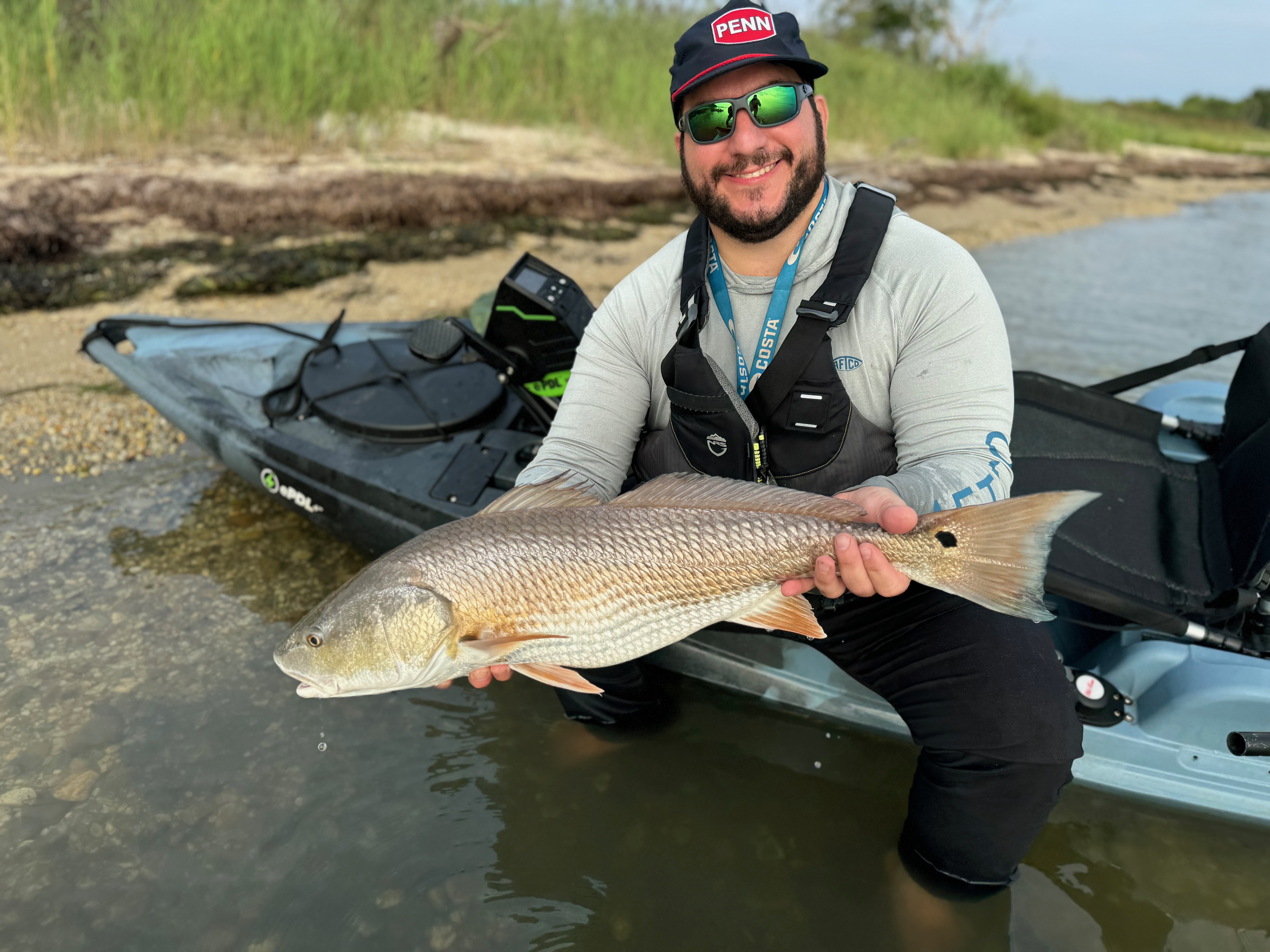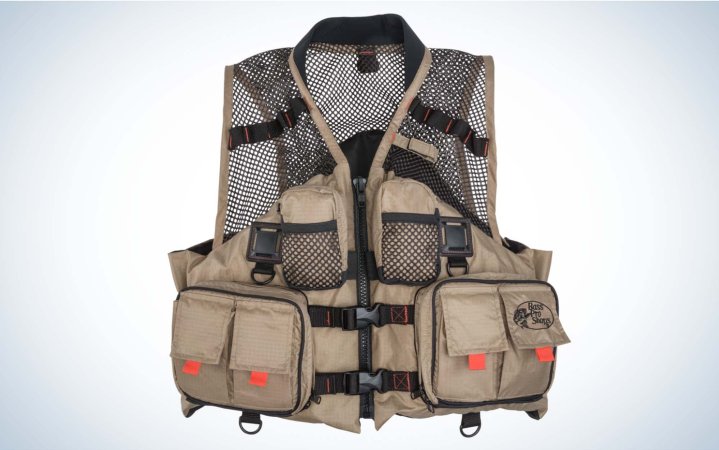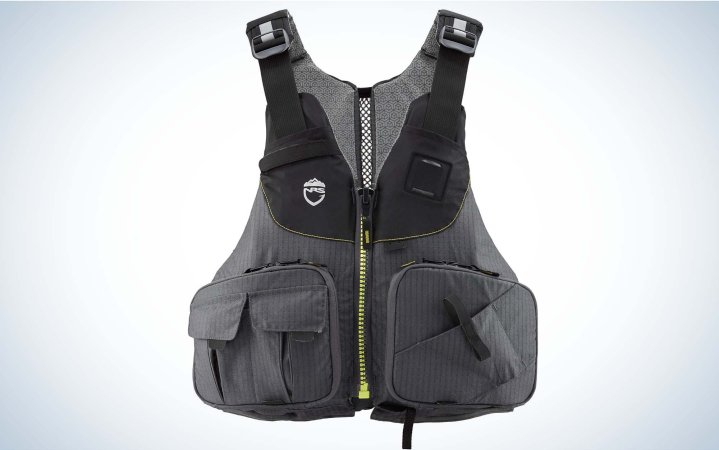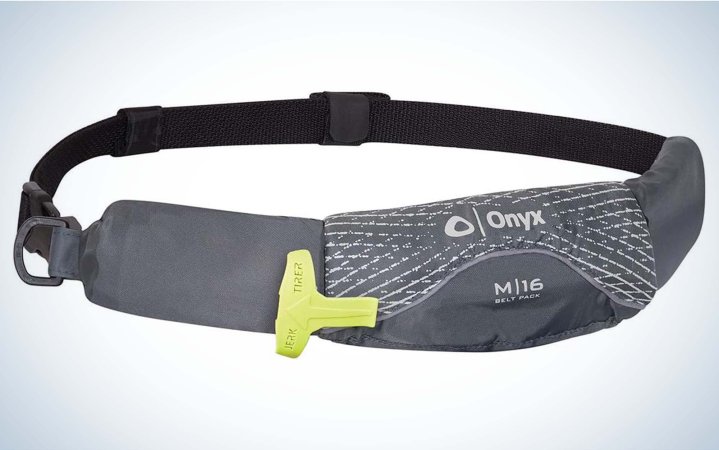We may earn revenue from the products available on this page and participate in affiliate programs. Learn More ›
The list of gear to remember for a day on the water is seemingly endless. While all the fancy new electronics and accessories are fun additions to any watercraft, everyone needs one critical accessory — a life jacket.
Unfortunately, many people disregard the importance of a good PFD or wearing them properly until it’s too late, often to tragic ends. The excuse for not wearing a life jacket is that the bulk inhibits movement and causes discomfort.
Fortunately, the current market is full of great PFD options that are specifically designed for a wide range of water activities, from casual boating to hardcore kayak angling. To help you find the best life jacket for your needs, I tested everything from full-size vests loaded with accessories to ultra-simple inflatables. Here are my top picks.
How I Tested the Best Life Jackets
Kevin Hughes
First I selected life jackets of different styles to test that are all U.S. Coast Guard approved. With the help of friends and family, I tested them on rivers, lakes, inshore, and the open ocean. Testing took place in summer, fall, and winter while fishing, paddling, and having fun on the water. That helped me determine what activities each life jacket is best for and how they fit while wearing a light fishing shirt or over layers in colder months.
Best Life Jackets: Reviews and Recommendations
Best for Kayak Fishing: NRS Chinook and Shenook
Key Features
- Weight: 2 pounds
- 16.5 pounds of flotation
- Type III
- Front zip entry
- Rod holder loop
- Strobe attachment point
- Reflective accents
- Knife lash tab
- Pockets with internal organization
- Shoulder strap keepers
Pros
- Lots of storage
- Designed specifically for kayak angling
- Comfortable while paddling
Cons
- Somewhat bulky
- Can be hot on warm days

Kevin Hughes

Kevin Hughes
The NRS Chinook, along with its female design-specific counterpart, the Shenook, is a staple for kayak anglers. It has a lot of gear storage and has six adjustment points for a custom fit. All the storage options on the Chinook are catered to what kayak anglers need, including a rod holder loop, knife holster, and external gear tab for holding pliers or other fishing accessories. While all the pockets and gear storage are a plus, I found they add bulk and can make this vest a little warm on hot summer days. It does have a mesh back, which helps vent some heat, though.
I liked that the high-back flotation design made paddling and fishing comfortable while seated in a kayak or canoe. The Chinook is a well-rounded kayak fishing vest and is a comfortable and extremely capable PFD for any kayak angler.
Read Next: Best Kayak Fishing Accessories
Best Automatic Inflatable: Onyx A/M-24 Inflatable Life Jacket
Key Features
- Water-activated or pull cord inflation
- Universal Size: Fits 30 to 52-inch chest
- Minimum 22.5 pounds buoyancy
- D-Ring attachment
- Convertible from automatic/manual to manual-only inflation
- Type V
Pros
- Lightweight
- Very comfortable
- Good buoyancy
Cons
- Minimal gear storage
- Needs to be re-armed if accidentally triggered
Inflatable PFD options are becoming more popular among watersports enthusiasts, mostly due to their minimalistic design and comfort. The Onyx A/M-24 inflatable vest is an excellent option in this category, providing a good level of buoyancy at 22.5 pounds and automatic inflation.
This PFD also allows the user to alternate between manual or automatic inflation methods. So if you’re wearing this PFD while paddle boarding where you plan on getting wet, you can set it to manual inflation only. Then, if you’re on a bass boat doing 40 mph, you can have it in automatic mode.
One of the biggest downfalls to any inflatable PFD is lack of storage space, and the Onyx A/M-24 is no exception. It has a D ring attachment and small Velcro pockets, allowing accessory attachment and storage.
I found this vest extremely comfortable and light to wear during long, hot days on the water. So, if comfort is a priority, the Onyx is a good option.
Best for Serious Kayak Anglers: Old Town Angler Lure II
Key Features
- USCG Type III
- Front zip entry
- Envelope pocket for radio or beverage
- Removable Velcro fly patch
- Reflective accents
- Knife lash tab
- Wide array of different pockets and attachments
- High back design
- Perforated neoprene shoulder straps with strap management system
Pros
- Lots of storage and attachment points
- Designed specifically for performance kayak angling
- Comfortable while paddling
Cons
- Expensive
- Assortment of pockets and straps can sometimes get in the way
This vest is the perfect combination of comfort and utility for kayak anglers who spend more time on the water than average weekend warriors. I found its lightweight design and breathable mesh easy to wear. The high back flotation was comfortable in a kayak seat all day. In addition to comfort, the Lure II also has more pockets and storage options than any other vest I’ve used.

Photo by Kevin Hughes
I was also pleasantly surprised that Old Town catered to fly fisherman by including a removable foam fly patch with a Velcro attachment.
Overall, this vest takes into consideration every style of fishing and on-the-water situation you may encounter, making it the perfect kayak fishing vest.
Best Low-Profile Foam Vest: NRS Ninja
Key Features
- Level 70 (Performance similar to Type III)
- Side entry
- Buoyancy: 15.75 pounds
- Large clamshell pocket
- Reflective accents
- Knife lash tab
- NRS Orbit fit design
- Compatible with NRS Swig Hydration pack
Pros
- Low-profile design stays out of your way
- Relatively inexpensive
- Comfortable while paddling
Cons
- Minimal storage
- Orbit fit side entry design isn’t the most comfortable for all body shapes
When it comes to low-profile life vests, it can be challenging to find non-inflatable options that allow for the same lightweight experience and comfort on the water. The NRS Ninja is a relatively simple but highly effective option for those looking to keep a minimal profile during a float.
The Ninja has a nice open feel that keeps the users’ arms and shoulders free to move about with ease. While storage is minimal, the large central clamshell pocket is large enough to accommodate necessities. There’s also a knife tab, hand warmer sleeve, and attachment options. The Ninja also features NRS’ relatively new Orbit fit design, which is a centrally-positioned, wrap-around system of specially cut foam that envelops the paddlers midsection for less bulky floatation elsewhere.
While the Orbit fit system is designed to conform to your body for comfort, it must be said that it can also make for an awkward fit on those with larger midsections. The design is initially very comfortable to wear, but I did find myself constantly pulling the vest back down to its proper positioning after paddling for a bit. Tightening the vest can help, but there’s a fine line between a good fit and one that causes discomfort.
Best Hybrid Foam/Inflatable: Mustang Survival Khimera
Key Features
- Level 70 (Performance similar to Type III)
- Manual inflation
- Weight: 1.95 pounds
- Universal fit
- 20.5l pounds total buoyancy (7.5 foam and 13 inflation)
- Over-the-head entry
- Front storage pocket
- Shoulder attachments for knife/strobe/gear
- Reflective shoulder patches
Pros
- Extremely lightweight
- Dual floatation provides comfort with added security in emergencies
- Comfortable while paddling
Cons
- Minimal storage
- Over-the-head design can be awkward to put on
The combination of inflatable and foam flotation makes this vest incredibly light and easy to wear, which is a huge benefit on hot or long days of intense activity. You have to pull the vest over your head to put it on , which can be annoying. But, the lack of straps or hardware helps contribute to the overall lightness and simplicity of the vest. The foam flotation provides peace of mind that you’ll still have a level of safety should you be unable to pull the inflation tab in an emergency.
This vest’s lightweight nature has some drawbacks, primarily in the storage department. One small front pocket and a shoulder attachment provide the only storage options, which is more inline with a typical inflatable than a full foam vest. That said, for users with the goal of simplicity and comfort on the water, the Khimera provides a great option with the benefits of both foam and inflatables.
Best Compact Kayak Fishing Vest: NRS Zander
Key Features
- Level 70
- Medium profile
- Buoyancy: 15.75 pounds
- Front-zip entry
- 4 front pockets
- MOLLE attachment strip
- Reflective shoulder patches
- Compatible with NRS Swig Hydration pack
- NRS Orbit Fit design
Pros
- Relatively lightweight and slim
- Lots of adjustment options
- Slightly cheaper than similar angling vests
Cons
- Less storage than other angling life jackets
- Orbit Fit system can be awkward for some body types
NRS introduced the Zander in 2024 as an alternative to their popular Chinook vest. The Zander features equally distributed flotation in the front and back, which provides a slimmer profile. Additionally, like the Ninja, it features the new Orbit Fit design that contours to a form fit around the user’s midsection.
The Zander has slightly less storage than other high-end angling vests, but the MOLLE attachment strip and pocket design are excellent for fishing-specific accessories such as pliers or leader spools. Like the Chinook, it features a strap management system that helps keep the numerous adjustment straps from getting in your way.

Photo by Kevin Hughes
While the Orbit Fit design is nice for fit and comfort, it doesn’t necessarily lend itself to fishing. The biggest problem I noticed was that the numerous straps and connection points tend to move around and catch line while making on the water adjustments to gear. Additionally, the central placement of the rear flotation makes leaning back and pedaling or casting somewhat awkward. Orbit Fit also features silicone anti-slipping strips around the midsection, which are intended to prevent the vest from moving when swimming or floating. Unfortunately, they also tend to stick to the angler’s shirt, causing it to ride up and rub in uncomfortable ways.
Best Manual Inflatable: NRS Matik
Key Features
- Weight: 1.8 pounds
- Provides 22.5 pounds of buoyancy
- Type III
- Zippered pocket with internal tether
- Mouth inflation valve
- Reflective accents
- 24 gram CO2 cartridge included
Pros
- Extremely comfortable
- Light
- Mouth inflation option in case CO2 cartridge fails
- More storage than most inflatables
Cons
- Relatively expensive
- Manual pull tab requires focus to activate

Kevin Hughes
As with the Onyx-A/M 24, the NRS Matik is a lightweight option that provides good buoyancy at 22.5 pounds. However, unlike its automatic counterpart, the Matik is a manual inflation vest. This means the inflation chord must be pulled to activate the CO2 cartridge and inflate the vest. While that requires more effort and thought than an automatic vest, it can be beneficial for more experienced paddlers and swimmers who don’t want to risk having a CO2 cartridge discharge accidentally. The Matik also provides a mouth inflation option, which is a nice backup in case the CO2 fails.
I liked that the Matik has better storage and accessory options than many inflatables. In addition to some Velcro liner pockets, this PFD also has a front-facing zipper pocket with a keyring attachment. While it’s not much, it’s just enough to separate it from some of the cheaper inflatables on the market and make it more appealing for serious kayakers or boaters.
Best Budget for Fishing: Bass Pro Shops Tournament Fishing Life Jacket
Key Features
- Type III
- Neoprene collar
- Mesh shoulders and upper back
- Full-zip front
- Two chest accessory loops
- Two chest lash tabs
- Rod holder
- Dual elastic tool loops
- Two zip chest pockets with outer mesh pockets
- Twolarge zip body pockets
- Body pockets have inner zip mesh pockets and accessory loops
- Outer hook-and-loop pockets
- Handwarmer pockets
- Two fold-down pockets with foam fly bench
- 3 D-rings
Pros
- Affordable
- Impressive storage and features for price
- Breathable mesh top makes for comfortable wear
Cons
- Durability
- The low position of the pockets and flotation makes for a slightly awkward fit while seated in a kayak
The BPS Tournament Fishing Life Jacket has more pockets than most anglers will know what to do with. I liked that all the pockets, rings, and loops will hold any accessory you need on the water. I also found the upper mesh breathable and comfortable in all seasons.
The biggest drawback to this vest is the placement of the flotation and storage. They’re at the bottom of the PFD, which isn’t ideal for kayak fishing, where you spend most of your time seated.
Additionally, while the price is exceptional for the features this vest provides, there’s no denying that it lacks the durability of the higher-end vests on this list. Despite its drawbacks, the BPS Tournament Fishing Life Jacket is a great option to have as a spare on your boat or for the kayak angler on a budget.
Best All-Purpose: NRS Raku
Key Features
- Weight: 2.1 pounds
- 5-panel design
- Rod holder loop
- Reflective accents
- Pockets with internal organization
- Shoulder strap keepers
- UL Certified
- Level 70 Buoyancy Aid
Pros
Cons
- Bulky
- It can be hot and uncomfortable

Kevin Hughes
While the NRS Chinook is undeniably the king of kayak fishing life vests, the NRS Raku provides many of the same features in a more multipurpose design. With a similar pocket and storage layout as the Chinook, the Raku is certainly at home in the world of kayak fishing. However, its traditional, five-panel design places the flotation around the midsection rather than the shoulders. This results in a vest better suited for a wider range of watercraft and activities than the Chinook while still firmly landing in the kayak fishing vest category. While this design provides good upper body mobility and is beneficial for things like rowing and wakeboarding, it can be a bit uncomfortable for pure kayak fishing. As with the BPS Tournament Vest, the placement of the flotation and storage around the midsection can be awkward and bulky when seated in a kayak. The design is also not as breathable as more fishing-oriented vests, making it a bit hot on warm days.
Best Budget for Paddling: Onyx MoveVent Dynamic Life Jacket
Key Features
- Mesh ventilation in front and back for breathability
- Mesh panel in back to accommodate most canoe and kayak seats
- Shoulder adjustments with neoprene comfort pads
- SOLAS grade reflective material for visibility
- Expandable zippered pocket with mesh drainage
- Lash tab for small accessories
- Marine whistle included
- Type III
Pros
- Comfortable kayak-friendly design
- Breathable
- Reasonably priced
Cons
- Minimal storage
- Not Durable
Some kayakers value feature rich PFDs, while others put more emphasis on comfort. The Onyx MoveVent Dynamic Life Jacket provides a simple middle ground for both at a reasonable price. While it certainly doesn’t have the pockets or accessory storage of the Chinook or Raku, it does have a high-back flotation design that’s comfortable to wear and fish out of while seated in a kayak. It has one large front-facing zippered pocket for storage, as well as a lash tab for accessories. Additionally, its barebones design makes it light and streamlined to paddle in while eliminating some of the annoying snags and sticking points of vests with more features. The simple design also makes this vest more comfortable for paddling than the bulkier, feature-rich vests on this list. The Onyx Movevent is a simple but effective all-purpose PFD at a price considerably lower than many other comparable vests.
Best Inflatable Belt PFD: Onyx M-16 Belt Pack
Key Features
- Weight: Less than 1 pound
- 17 pounds of buoyancy
- Additional mouth inflation tube for buoyancy up to 26.5 pounds
- Secure pull clips to life jacket
- 1-inch buckle and body belt
- Type V
Pros
- Low profile
- Lightweight
- Buoyant
- Comfortable to wear on hot days
Cons
- Not as much buoyancy from CO2 alone as inflatable vests
- Belt placement doesn’t provide the same level of protection as vests
Some days are just made for relaxing and paddling in the sun. While it can be nice to soak in the rays on a boat, it’s still critical to have a PFD. The Onyx M-16 Belt Pack is a great option for if you’re looking for something more comfortable and less obtrusive than a vest. While the C02 cartridge alone provides 17 pounds of buoyancy, the M-16 also includes a mouth inflation option that can increase that to 26.5 pounds. The ultra-slim and lightweight design of this belt pack is ideal for casual wear on hot days. The slim design does create a storage issue, as the M-16 doesn’t provide much in the way of pockets or accessory holders. Additionally, a belt pack doesn’t provide the same level of upper body support as a vest, so it’s important to consider where and when you may need to activate it and plan accordingly.
How to Choose the Life Vest for You

Kevin Hughes
The number one factor in choosing a PFD should always be safety. Make sure the vest is rated for the proper weight, as well as the situations you plan on using it in. There are several life jacket rating systems in place, as well as U.S. Coast Guard requirements, and it’s critical that you understand what is legally required based on where and when you’ll be using the vest.
Here are some guidelines from the Coast Guard:
- Most adults only need 7 to 12 pounds of buoyancy (31 to 53 Newton) to keep their heads above water.
- When worn correctly a foam filled lifejacket will fit snugly, and will not allow the lifejacket to rise above the wearer’s chin or ears.
- To meet U.S. Coast Guard requirements, a recreational vessel must have a U.S. Coast Guard Approved lifejacket for each person aboard.
- Some styles of lifejackets are not intended for weak or non-swimmers (read the label and be honest).
- More info.
Life Jacket Types and Performance Levels

Photo by Kevin Hughes
You’ll see life jackets with specifications like Type III or Level 100. These refer to their buoyance and how they floatation supports the wearer. Here’s a breakdown from the USCG on what each means as well as weight ratings.
Life Jacket Types
- Type I: The greatest required inherent buoyancy and turns most unconscious persons in the water from a face down position to a vertical and slightly backward position, therefore, greatly increasing one’s chance of survival.
- Type II: Intended to turn some unconscious persons from a face down position in the water to a position where the wearer’s respiration is not impeded.
- Type III: Intended to support a conscious person in the water in an upright position. This type of device is not required to turn an unconscious person in the water from a face-down position to a position where the wearer’s respiration is not impeded.
- Type V: Is approved for restricted uses or activities such as boardsailing, or commercial white water rafting. These devices may not be suitable for other boating activities. The label indicates whether a particular design of Type V can be used in specific application, what restrictions or limitations apply, and its performance type.
Performance Level Devices
- Level 50: Intended for use by those who are competent swimmers and who are near to bank or shore, or who have help and a means of rescue close at hand.
- Level 70: Intended for use by those who have help or a means of rescues close at hand, or who are near bank or shore. These devices have minimal bulk, but cannot be expected to keep the user safe for a long period of time in disturbed water.
- Level 100: Intended or those who may have to wait for rescues, but are likely to do so in sheltered water. The device should not be used in rough water.
- Level 150: Intended for general application or for use with foul weather clothing. It will turn an unconscious person into a safe position and requires no subsequent action by the user to maintain this position.
- Level 275: Intended primarily for offshore use under extreme conditions.
Lifejackets Weight Categories
- Adult : Users with a weight greater than 88 pounds
- Youth: Users with a weight over 55 pounds and less than or equal to 88 pounds
- Child: Users with a weight over 33 pounds and less than or equal to 55 pounds
- Infant: Users with a weight less than or equal to 33 pounds
The Best Life Jacket Is the One You’ll Wear
Next, consider whether comfort or functionality is more important to you. If you’re an active paddle kayaker, you’ll probably want a vest more suited to mobility and comfort. If you’re a dedicated angler and use your kayak solely for fishing, something with better gear storage and functionality is probably up your alley. Lastly, if you’re just out for a day on the water and need something unobtrusive to ensure safety and legality, maybe an inflatable is your best choice.
Ultimately, trying different vests on and testing them out is the best way to decide what suits you.
Final Thoughts on the Best Life Jackets
While they aren’t glamorous, life jackets are absolutely one of the most important items that anyone needs on the water. They may not always be comfortable or stylish, but this list of the best life vests works hard to solve those issues. There are plenty of great PFD options on the market, and hopefully, you can find one that perfectly suits you. No matter which you choose, just remember how critical it is to wear a good PFD. After all, it can literally save your life.











